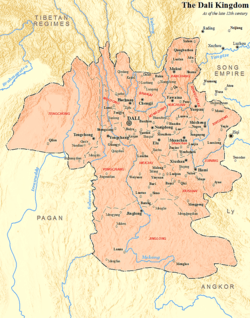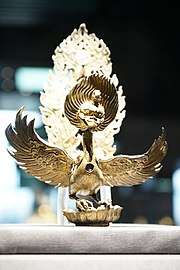Dali Kingdom
Dablit Guaif 大理國 | |||||||||
|---|---|---|---|---|---|---|---|---|---|
| 937–1253 | |||||||||
 Map of Dali Kingdom in late 12th century | |||||||||
| Capital | Dali | ||||||||
| Common languages |
Bai | ||||||||
| Religion | Buddhism | ||||||||
| Government | Monarchy | ||||||||
| Emperor | |||||||||
• 937–944 | Duan Siping | ||||||||
• 1081–1094 | Duan Zhengming | ||||||||
• 1096–1108 | Duan Zhengchun | ||||||||
• 1172–1200 | Duan Zhixing | ||||||||
• 1251–1254 | Duan Xingzhi | ||||||||
| History | |||||||||
• Established | 937 937 | ||||||||
| 1095 | |||||||||
• Reestablished | 1096 | ||||||||
• Ended by the Mongol Empire | 1253 1253 | ||||||||
| |||||||||
| Dali Kingdom | |||||||||
| Chinese name | |||||||||
|---|---|---|---|---|---|---|---|---|---|
| Traditional Chinese | 大理國 | ||||||||
| Simplified Chinese | 大理国 | ||||||||
| Literal meaning | State of Dali | ||||||||
| |||||||||
| Alternative Chinese name | |||||||||
| Traditional Chinese | 大中國 | ||||||||
| Simplified Chinese | 大中国 | ||||||||
| |||||||||
| Later Dali | |||||||||
| Traditional Chinese |
後大理 後理國 | ||||||||
| Simplified Chinese |
后大理 后理国 | ||||||||
| |||||||||
| Bai name | |||||||||
| Bai | Dablit Guaif | ||||||||
The Dali Kingdom, also known as the Dali State (simplified Chinese: 大理国; traditional Chinese: 大理國; pinyin: Dàlǐ Guó; Bai: Dablit Guaif), was a kingdom situated in modern Yunnan province, China from 937 until 1253 when it was conquered by the Mongols. Its kings continued to administer the area as Mongol vassals until the Ming conquest of Yunnan.[1]
History
Origins
Nanzhao was overthrown in 902 and three dynasties followed in quick succession before Duan Siping seized power in 937, establishing himself at Dali.[2] The Duan clan professed to have Han ancestry.[3]
Relations with the Song dynasty
Dali's relationship with the Song was cordial throughout its entire existence. Dali congratulated the Song dynasty on the conquest of Later Shu in 965 and voluntarily established tribute relations in 982. It was however essentially an independent state. At times the Song even declined offers of tribute.[2]
Dali's primary importance to the Song dynasty was its horses, which were highly prized and sought after as military assets, especially after the fall of the Northern Song. They were described by a Song official in the following passage:
These horses possess a shape [that is] quite magnificent. They stand low with a muscular front, very similar to the shape of a chicken. The diaphragm is broad, shoulders thick, waist flat, and back round. They are trained to squat on their rear ends like a dog. They easily climb steep terrain on command and possess both speed and agility in chase. They have been raised on bitter buckwheat, so they require little to maintain. How could a horse like this not be considered a good horse?[4]
Fall
In 1252 Möngke Khan placed his brother Kublai in charge of invading Dali. In 1253 Kublai's army crossed the Jinsha River and received the surrender of Duan Xingzhi, who presented to Möngke in 1256 maps of Yunnan. Duan Xingzhi of Dali was enfieffed as Maharaja (摩诃罗嵯) by Kublai Khan,[5] and the Duan royal family continued to hold the title of Maharaja in Yunnan as vassals to the Mongols under the supervision of Mongolian imperial princes and Muslim governors. The Duan family reigned in Dali while the governors served in Kunming. After the Ming conquest of Yunnan,[6] The Duan royals were scattered in various distant areas of China by the Hongwu Emperor.[7]
Yunnan under the Mongols
The Duan family governed Yunnan's various indigenous peoples for 11 generations until the end of Mongol rule. They willingly contributed soldiers to the Mongol campaign against the Song dynasty. They also aided the Yuan dynasty in putting down a Mongol rebellion in Yunnan in 1271.[7]
In 1274 Sayyid Ajjal Shams al-Din Omar was assigned by Kublai to stabilize Yunnan. He instituted a native chieftain system that came to be known as tusi which assigned ranks and posts to native chieftains. Under this institution of "rule based on native customs" the locals retained much of their autonomy with the exception of three obligations. One, they would provide surrendered troops to the Yuan government. Two, local chieftains would provide tribute to the Yuan court. Three, they would follow the rules of appointment, succession, promotion, degradation, reward, and punishment of native chieftains created by the Yuan court.[7]
Yuan rule also introduced a significant Muslim influence into Yunnan.[7]
Religion

A version of Buddhism known as Azhali existed in Yunnan since the 9th century. The last king of Nanzhao established Buddhism as a state religion and many Dali kings continued the tradition. Ten of Dali's 22 kings retired to become monks.[8]
Family Tree of the Kings of Dali
| Family Tree of the Kings of Dali | |||||||||||||||||||||||||||||||||||||||||||||||||||||||||||||||||||||||||||||||||||||||||||||||||||||||||||||||||||||||||||||||||||||||||||||||||||||||||||||||||||||||||||||||||||||||||||||||||||||||||||||||||||||||||||||||||||||||||||||||||||||||||||||||||||||||||||||||||||||||||||||||||||||||||||||||||||||||||||||||||||||||||||||||||||||||||||||||||||||||||||||||||||||||||||||||||||||||||||||||||||||||||||||||||||||||||||||||||||||||||||||||||||||||||||||||||||||||||||||||||||||||||||||||||||||||||||||||||||||||||||||||||||||||||||||||||||||||||||||||||||||||||||||||||||||||||||||||||||||||||||||||||||||||||||||||||||||||||||||||||||||||||||||||||||||||||||||||||||||||||||||||||||||||||||||||||||||||||||||||||||||||||||||||||||||||||||||||||||||||||||||||||||||||||||||||||||||||||||||||||||||||||||||||||||||||||||||||||||||||||||||||||||||||||||||||||||||||||||||||||||||||||||||||||||||||||||||||||||||||||||||||||||||||||||||||||||||||||||||||||||||||||||||||||||||||||||||||||||||||
|---|---|---|---|---|---|---|---|---|---|---|---|---|---|---|---|---|---|---|---|---|---|---|---|---|---|---|---|---|---|---|---|---|---|---|---|---|---|---|---|---|---|---|---|---|---|---|---|---|---|---|---|---|---|---|---|---|---|---|---|---|---|---|---|---|---|---|---|---|---|---|---|---|---|---|---|---|---|---|---|---|---|---|---|---|---|---|---|---|---|---|---|---|---|---|---|---|---|---|---|---|---|---|---|---|---|---|---|---|---|---|---|---|---|---|---|---|---|---|---|---|---|---|---|---|---|---|---|---|---|---|---|---|---|---|---|---|---|---|---|---|---|---|---|---|---|---|---|---|---|---|---|---|---|---|---|---|---|---|---|---|---|---|---|---|---|---|---|---|---|---|---|---|---|---|---|---|---|---|---|---|---|---|---|---|---|---|---|---|---|---|---|---|---|---|---|---|---|---|---|---|---|---|---|---|---|---|---|---|---|---|---|---|---|---|---|---|---|---|---|---|---|---|---|---|---|---|---|---|---|---|---|---|---|---|---|---|---|---|---|---|---|---|---|---|---|---|---|---|---|---|---|---|---|---|---|---|---|---|---|---|---|---|---|---|---|---|---|---|---|---|---|---|---|---|---|---|---|---|---|---|---|---|---|---|---|---|---|---|---|---|---|---|---|---|---|---|---|---|---|---|---|---|---|---|---|---|---|---|---|---|---|---|---|---|---|---|---|---|---|---|---|---|---|---|---|---|---|---|---|---|---|---|---|---|---|---|---|---|---|---|---|---|---|---|---|---|---|---|---|---|---|---|---|---|---|---|---|---|---|---|---|---|---|---|---|---|---|---|---|---|---|---|---|---|---|---|---|---|---|---|---|---|---|---|---|---|---|---|---|---|---|---|---|---|---|---|---|---|---|---|---|---|---|---|---|---|---|---|---|---|---|---|---|---|---|---|---|---|---|---|---|---|---|---|---|---|---|---|---|---|---|---|---|---|---|---|---|---|---|---|---|---|---|---|---|---|---|---|---|---|---|---|---|---|---|---|---|---|---|---|---|---|---|---|---|---|---|---|---|---|---|---|---|---|---|---|---|---|---|---|---|---|---|---|---|---|---|---|---|---|---|---|---|---|---|---|---|---|---|---|---|---|---|---|---|---|---|---|---|---|---|---|---|---|---|---|---|---|---|---|---|---|---|---|---|---|---|---|---|---|---|---|---|---|---|---|---|---|---|---|---|---|---|---|---|---|---|---|---|---|---|---|---|---|---|---|---|---|---|---|---|---|---|---|---|---|---|---|---|---|---|---|---|---|---|---|---|---|---|---|---|---|---|---|---|---|---|---|---|---|---|---|---|---|---|---|---|---|---|---|---|---|---|---|---|---|---|---|---|---|---|---|---|---|---|---|---|---|---|---|---|---|---|---|---|---|---|---|---|---|---|---|---|---|---|---|---|---|---|---|---|---|---|---|---|---|---|---|---|---|---|---|---|---|---|---|---|---|---|---|---|---|---|---|---|---|---|---|---|---|---|---|---|---|---|---|---|---|---|---|---|---|---|---|---|---|---|---|---|---|---|---|---|---|---|---|---|---|---|---|---|---|---|---|---|---|---|---|---|---|---|---|---|---|---|---|---|---|---|---|---|---|---|---|---|---|---|---|---|---|---|---|---|---|---|---|---|---|---|---|---|---|---|---|---|---|---|---|---|---|---|---|---|---|---|---|---|---|---|---|---|---|---|---|---|---|---|---|---|---|---|---|---|---|---|---|---|---|---|---|---|---|---|---|---|---|---|---|---|---|---|---|---|---|---|---|---|---|---|---|---|---|---|---|---|---|---|---|---|---|---|---|---|---|---|---|---|---|---|---|---|---|---|---|---|---|---|---|---|---|---|---|---|---|---|---|---|---|---|---|---|---|---|---|---|---|---|---|---|---|---|---|---|---|---|---|---|---|---|---|---|---|---|---|---|---|---|---|---|---|---|---|---|---|---|---|---|---|---|---|---|---|---|---|---|---|---|---|---|---|---|---|---|---|---|---|---|---|---|---|---|---|---|---|---|---|---|---|---|---|---|---|---|---|---|---|---|---|---|---|---|---|---|---|---|---|---|---|---|---|---|---|---|---|---|---|---|---|---|---|---|---|---|---|---|---|---|---|---|---|---|---|---|---|---|---|---|---|---|---|---|---|---|---|---|---|---|---|---|---|---|---|---|---|---|---|---|---|---|---|---|---|---|---|---|---|---|---|---|---|---|---|---|---|---|---|---|---|---|
| |||||||||||||||||||||||||||||||||||||||||||||||||||||||||||||||||||||||||||||||||||||||||||||||||||||||||||||||||||||||||||||||||||||||||||||||||||||||||||||||||||||||||||||||||||||||||||||||||||||||||||||||||||||||||||||||||||||||||||||||||||||||||||||||||||||||||||||||||||||||||||||||||||||||||||||||||||||||||||||||||||||||||||||||||||||||||||||||||||||||||||||||||||||||||||||||||||||||||||||||||||||||||||||||||||||||||||||||||||||||||||||||||||||||||||||||||||||||||||||||||||||||||||||||||||||||||||||||||||||||||||||||||||||||||||||||||||||||||||||||||||||||||||||||||||||||||||||||||||||||||||||||||||||||||||||||||||||||||||||||||||||||||||||||||||||||||||||||||||||||||||||||||||||||||||||||||||||||||||||||||||||||||||||||||||||||||||||||||||||||||||||||||||||||||||||||||||||||||||||||||||||||||||||||||||||||||||||||||||||||||||||||||||||||||||||||||||||||||||||||||||||||||||||||||||||||||||||||||||||||||||||||||||||||||||||||||||||||||||||||||||||||||||||||||||||||||||||||||||||||
Art
Citations
- ↑ Theobald, Ulrich (17 August 2012), "Dali 大理", China Knowledge .
- 1 2 Yang 2008a.
- ↑ Frederick W. Mote (2003). Imperial China 900-1800. Harvard University Press. pp. 710–. ISBN 978-0-674-01212-7.
- ↑ Herman 2007, p. 40.
- ↑ Yang 2008c.
- ↑ Frederick W. Mote; Denis Twitchett (26 February 1988). The Cambridge History of China: Volume 7, The Ming Dynasty, 1368-1644. Cambridge University Press. pp. 144–. ISBN 978-0-521-24332-2.
- 1 2 3 4 Yang 2008b.
- ↑ "Nanzhao State and Dali State". City of Dali. Archived from the original on 2006-09-03.
References
- Herman, John E. (2007), Amid the Clouds and Mist China's Colonization of Guizhou, 1200–1700, Harvard University Asia Center, ISBN 978-0-674-02591-2
- Yang, Bin (2008a), "Chapter 3: Military Campaigns against Yunnan: A Cross-Regional Analysis", Between Winds and Clouds: The Making of Yunnan (Second Century BCE to Twentieth Century CE), Columbia University Press
- Yang, Bin (2008b), "Chapter 4: Rule Based on Native Customs", Between Winds and Clouds: The Making of Yunnan (Second Century BCE to Twentieth Century CE), Columbia University Press
- Yang, Bin (2008c), "Chapter 5: Sinicization and Indigenization: The Emergence of the Yunnanese", Between Winds and Clouds: The Making of Yunnan (Second Century BCE to Twentieth Century CE), Columbia University Press
External links

